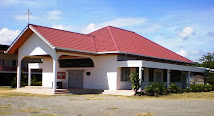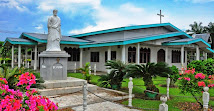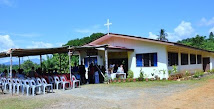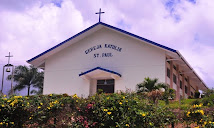Article by DaliusLL
Photos by Leonad
Sandakan: Bishop Julius Dusin Gitom presided over the bi-lingual Holy Thursday Mass of the Lord's Supper at St. Mary's Cathedral on 24th March 2016 at 7.30pm. More than 1,500 parishioners attended the Holy Mass.
Photos by Leonad
Sandakan: Bishop Julius Dusin Gitom presided over the bi-lingual Holy Thursday Mass of the Lord's Supper at St. Mary's Cathedral on 24th March 2016 at 7.30pm. More than 1,500 parishioners attended the Holy Mass.
Holy Thursday is the commemoration of the Last Supper of Jesus Christ,
when he established the Sacrament of Holy Communion prior to his arrest and
crucifixion. It also commemorates His institution of the priesthood. The holy
day falls on the Thursday before Easter and is part of Holy Week. Jesus
celebrated the dinner as a Passover feast on which fulfilled His role as the
Christian victim of the Passover for all to be saved by His final sacrifice. This
establishment of the priesthood is re-enacted at Mass with the priest washing the
feet of 12 parishioners.
In his homily, the prelate reminded that Holy Thursday marks the beginning of the Paschal Triduum that is a three holy days before the resurrection of the Lord. By
celebrating this paschal meal, the Lord wants to liberate us from whatever that
oppressed us just like the passover where God intervened in the human history
in liberating the Israelites from slavery in Egypt.
This evening as in St. John‘s Gospel, the hour of the Lord, the high point of His saving work, depicts a new exodus with His passing through this world to the Father. Sharing in this new exodus is an ultimate liberation to free us from enslavement from sins, setting us free because of God’s love. This is the clearest manifestation of His love and mercy for humankind and bringing us back to Him. This is a self-giving kind of love which Jesus wishes to be kept alive among us. The celebration of the Eucharist is the living memorial through which we are joined to the Lord's saving act of love.
This evening as in St. John‘s Gospel, the hour of the Lord, the high point of His saving work, depicts a new exodus with His passing through this world to the Father. Sharing in this new exodus is an ultimate liberation to free us from enslavement from sins, setting us free because of God’s love. This is the clearest manifestation of His love and mercy for humankind and bringing us back to Him. This is a self-giving kind of love which Jesus wishes to be kept alive among us. The celebration of the Eucharist is the living memorial through which we are joined to the Lord's saving act of love.
Jesus also did something unique by washing the feet of his disciples. By
letting Him wash our feet, the lowest part of our body which is always in
contact with dirt, is accepting His great act of loving service. We are to understand the close connection between the Eucharist and service.
Having accepted the gift we must embrace and to practice in our life
what Jesus did in His passion. It shows us how to live; to live for God and to live
for others in humility.
The prelate challenges everyone to reflect on, “if we are so willing to
celebrate the Eucharist on every Sunday or perhaps every day, are we willing to
serve others?” He concluded by saying, 'let us pray that we may have the spirit
of the Lord and strengthen by the Eucharist we can go out to serve with
humility.'
After the mass, the Holy Eucharist was carried in procession and then transferred into the place of reposition. The faithful, either individuals or in groups remained and continued adoration of the Blessed Sacrament until midnight.
After the mass, the Holy Eucharist was carried in procession and then transferred into the place of reposition. The faithful, either individuals or in groups remained and continued adoration of the Blessed Sacrament until midnight.






























.JPG)







No comments:
Post a Comment